Posted in Blog by Jo North
Creative Tools & Techniques for Business Planning Sessions
I really enjoy facilitating business growth workshops and run several each month.

As well as helping delegates to work on their business plans, I design my events so that delegates can get away from the day to day – mentally as well as physically – refresh their thinking, re-energise and re-boot their motivation. I want delegates to leave feeling excited, clear about their next steps and inspired to take their business to the next level.
Getting delegates’ minds out of the day to day is really important. And if they are working with their colleagues, I also want them to share ideas, have great conversations, maybe some debate, agree priorities, and get a clear action plan so that they can all move forward together.
Here are some of my favourite, proven, tried-and-tested creative techniques for facilitating business growth. And if you’re not a facilitator, or maybe you’re a solopreneur, you can use every one of these techniques on your own, in a sort of creative business retreat for one.
The key areas to cover, depending on the time you have available, are:
- External market trends and developments (also known as a macro-environmental analysis);
- Customer needs and aspirations;
- Competition;
- Internal strengths, aspirations and goals;
- Differentiators (also known as USP, or unique selling point).
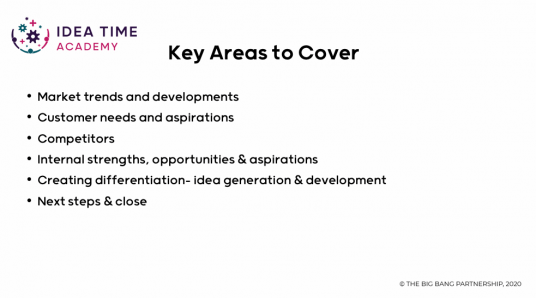
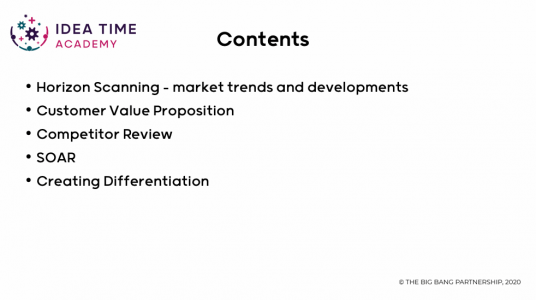
In this article I’m going to share a tool that you can use for each of these key areas, starting with my Horizon Scanning technique for external market trends and developments.
Obviously, before getting stuck into the core content, it’s important to have a great session opener, agree objectives and go through the agenda.
Once that’s done, my Horizon Scanning technique is a super-effective way of getting everyone talking, sharing and looking outside the business. Before the event collect lots of different newspapers and magazines. Ask your delegates to use them as a stimulus by browsing the newspapers and magazines, cutting or tearing out headlines, pictures, adverts – anything that they think is relevant – in response to this brief.
Horizon Scanning Brief
Use the resources / idea generators provided (newspapers & magazines, glue, pens, scissors) and your own thoughts to create a poster/posters as follows:
- Identify a range of themes that could be opportunities
or challenges for your business / project between now and (insert your date of
choice). Feel free to use your imagination and be creative!
- Key prompts to consider are: social change, technology, environment, economy, political developments
- For each theme, explain why it might be an opportunity or challenge
Provide glue sticks so that delegates can stick their images and words down to create a collage, which they will then present back and talk through. Sometimes delegates mya be a bit slow to start, but honestly, once they get going, they don’t want to stop the cutting and sticking, they really enjoy it and chat with each other as they go. Getting hands on, and using words and pictures also activates different parts of the brain and triggers different thinking.
When the delegates are presenting back their posters, I always capture their key phrases on a flipchart and ask questions to stimulate debate and get more depth.
Customer Value Proposition Map (Osterwalder)
The Horizon Scanning activity starts things off by looking at the outside world more broadly. Next it is time to zoom in on customers. Osterwalder’s Customer Value Proposition Map is an excellent tool for this. The questions it asks seem simple on the surface but working on the answers always gets delegates really thinking about what customers really want and how the business truly serves them.
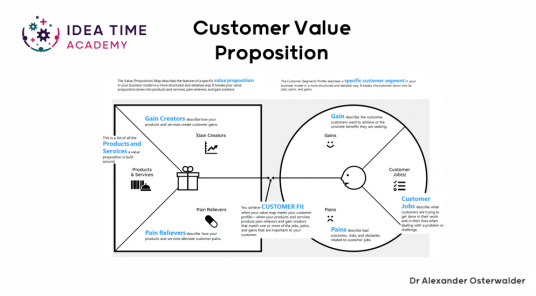
We are all in business to solve customers’ problems. Those problems could be really small, they don’t all have to be lifechanging.
For instance, one of my favourite products at home is my slanket, a blanket with sleeves. The slanket was created by a student in America, Gary Clegg. He didn’t want to have to take his arm out of the top of his blanket to change channels on the remote control, so he got his Mum to make him a slanket. His friends then wanted one, so his Mum made more, it grew, and Gary Clegg is now a multi-millionaire. So, customer pain points can be really small. The important thing is to get delegates talking about customers, and really thinking about what different customer segments want from the business.
Competitor Analysis
Moving on now to competitors, I first ask delegates to identify their most significant customers. Next, they do a review of how well they think each competitor performs from the customer perspective, giving each competitor a score out of 5 for quality, innovation, customer service, speed and price on the graphic below. You can add in more items to suit the needs of your delegates’ specific business. Ask delegates to put blobs or dots onto the score for each item, then join up the dots to show the ‘shape’ for each competitor, doing each competitor in a different colour.
Finally, invite delegates to do exactly the same process again, this time for their own business.
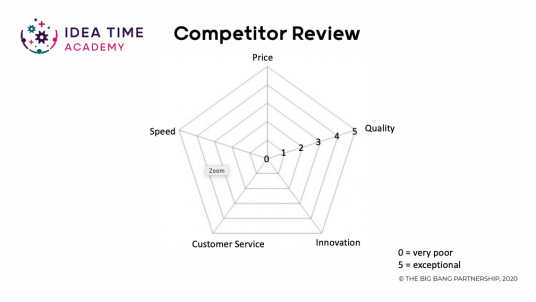
This is another simple activity but one that reveals some surprising and helpful insights for delegates. On some occasions, delegates have realised that they don’t know as much about the competition as they would like to. On others, the ‘shapes’ reveal where there is ‘sameness’ in the market, or opportunity to differentiate more strongly.
Looking Inside
All of that has been looking outside the business. Now it’s time to draw together the threads from the externally-focused activities and think about the strengths and aspirations of the business in the context of its environment. SOAR is one of my favourite techniques for this.
SOAR stands for Strengths, Opportunities, Aspirations, Results. It’s an excellent alternative to the often-used, traditional SWOT analysis.
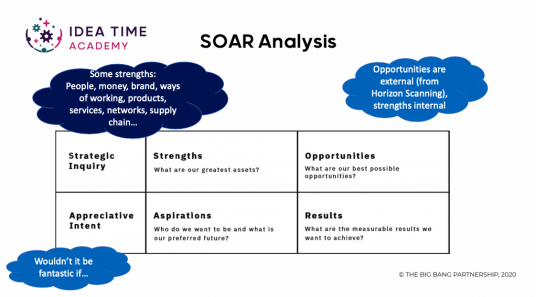
SOAR is strengths-based, consistent with an approach known as ‘Appreciative Inquiry’. This focuses on achieving successful change management by identifying what is working well and then doing more of it, because people (and therefore organisations) will grow in whichever direction people focus their attention.
For more about the origins and details of the SOAR technique, read The Thin Book of SOAR: Building Strengths-Based Strategy, by Stavros & Hinrichs.
Create a grid like the one shown here and ask delegates to consider the business’ internal Strengths, and external Opportunities -by combining the previous Horizon Scanning, Customer Value Proposition and Competitor Review activities.
It is interesting because people ask, ‘What about threats?’ A threat is the same as an opportunity, it is just a different way of looking at the same thing. If delegates raise a threat, ask delegates to think about how they could turn that threat into an opportunity.
A is for Aspirations. This is where you get delegates to think about their ambitious goals. Encourage them to think big, think differently, and be bold.
The final part of the SOAR is Results, i.e. what are the results associated with those aspirations?
An aspiration is an ambition, the results are the measurable outcomes that show the ambition has been achieved. Examples of measurable results are to double the turnover, achieve 60% market share; reduce costs by 10%, and so on.
Competitive Differentiation – 4 Questions
My final activity in our facilitation agenda for Business Growth is the 4 Questions technique for identifying and communicating competitive differentiation.
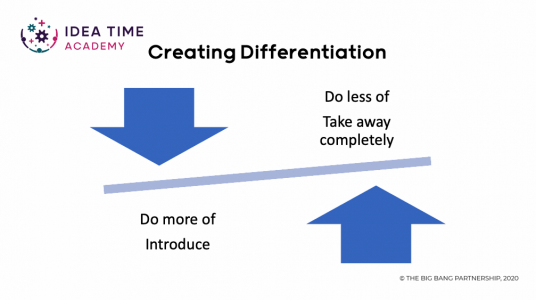
Invite delegates to consider, discuss and write down their ideas in response to these 4 questions:
- What things are competitors doing, and that customers value, that the business could do more of?
- What things are competitors NOT doing, and that customers would value, that the business could start doing?
- What things are competitors doing, and that don’t matter to customers, that the business could do less of?
- What things are competitors doing, and that don’t matter to customers, that the business could stop doing?
Or, put more simply:
- What could the business do more of?
- What could the business introduce?
- What could the business do less of?
- What could the business take away completely?
Premier Inn example
I think that Premier Inn is a great example of a business that applied this approach to create a successful budget brand by using these questions to create a new value proposition in contrast with standard hotel chains.
Premier Inn have …
…done more with the quality of beds, bedding and pillows, to focus on giving customers a good night’s sleep, which is an important part of the hotel experience. Premier Inn have also gone further with high standards of cleanliness, customer service and brand consistency in comparison with other budget brands.
…introduced a ‘good night guarantee’, promising to give customers their money back if they don’t sleep well due to an issue with the room. Other hotels don’t offer this, to my knowledge.
…done less when it comes to the quality and availability of items such as shower gel, loo roll and towels. They provide a very basic option, but nothing fancy. Customers don’t mind (I take my own!) and are happy to accept the compromise in exchange for a lower price.
…taken away the mini bar, facility to open an account, room service, gyms and pools and much more. But customers don’t mind because the price is less.
Putting it All Together
These activities help delegates to step outside their business and focus on the future. The final items of the event will include reviewing all the outputs from the activities and creating a clear, shared action plan, feedback, thank yous and close.
Access More Facilitation Tools & Techniques
If you’d like 24/7 access to more agendas, facilitation time-savers and fresh creative tools and techniques, why not check out my Idea Time Academy. It’s packed with resources and training to help you to expand your creativity, impact and confidence as a facilitator.
Hope to see you in inside! If you’d like to know more, please do get in touch with me at jo@bigbangpartnership.co.uk. I’d love to hear from you and we can set up a video call and I’ll show you round on screen.

